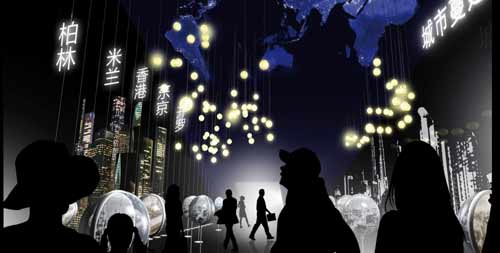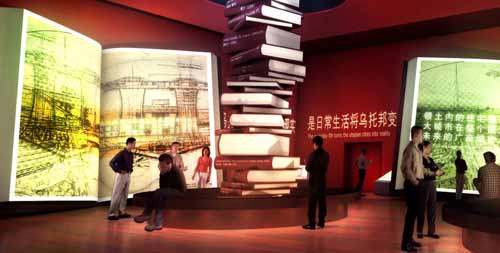|
|


ADVERTISEMENT
Buy Your own advertising
spaces!
.
Download Adobe Acrobat Reader to open [PDF] files.
Recent Visitors
Design stories behind three theme pavilions at Shanghai Expo
2010. 28 April
 Urban Planet
Urban Planet
(news.xinhuanet.com)
As hopes run high to make this year's World Expo in Shanghai a spectacular visual gala, the theme pavilions at the Shanghai Expo Park take on an unusual mission to demonstrate how a better city can make a better life.
As the successful bidders, design teams from Germany, the Netherlands and Spain were granted the opportunity to lay out such three theme pavilions as "Urban Planet," "Urban Dwellers" and "Urban Future."
URBAN PLANET: COEXISTENCE OF CITY, EARTH
The "Urban Planet" pavilion is a must for visitors who want to obtain a full understanding of the theme of "Better city, Better life," said Lutzer Engelke, Managing Partner and Founder of Triad Berlin, a German design company.
As the designer of the theme pavilions for the Hanover World Expo 2000, Triad is widely regarded as an experienced professional firm in the business.
Engelke said the pavilion would illustrate the resurrection process of the Earth after it "withers" and "dies" from heavy pollution, thanks to the human salvation efforts.
Triad put in the pavilion a set of prolonged, helix-shaped couplet corridors through which visitors can walk through the "crisis," "damage" and "solution" to the Earth. This design is made to remind people of all kinds of the challenges confronting the Earth and to present them various possible solutions for sustainable development.
Triad also managed to rally multinationals like Bosch and Daimler, which will bring along their green solutions for the exhibition.
Reviewing the bidding battle, Engelke said: "No one can assure you of any success, but as we survived five rounds of screening, we emerged triumphant in the bidding process anyway."
"URBAN DWELLERS": STORY ABOUT ORDINARY CITY LIFE
Herman Kossman and his colleagues from the Amsterdam-based design studio Kossmann.dejong know well that people are the core of a city. Thus, they and their partners would use video clips to show the life of six families from different places of the world in the "Urban Dwellers" pavilion.
This approach is meant to help visitors perceive the aspiration of those families for a better life, according to the designers.
"Telling stories is more convincing than generalizing; thus we are determined to present our major thoughts that way," said Kossmann, design director at Kossmann.dejong, adding that urbanization should be made conducive to people's various needs.
According to the designers, the six families are quite different in terms of lifestyles, the wealth status, education, and family structure. These differences are deliberately taken to show the diversity of the social structure and people's livelihood.
The "Urban Dwellers" pavilion consists of five parts -- family, job, communication, learning and health. Most notably, designers laid out a number of mirrors all over the ceiling and floor, in addition to make three-dimensional video of the families' life, so that visitors can observe from different angles.
Kossman also said that the whole pavilion actually makes a "changing and colorful city." Multi-media and other devices are adopted to show the diversity of life, such as different families, working environments, and mankind's pursuit and wishes of all sorts.
"URBAN FUTURE": FUTURE DREAMS
 The design work of the "Urban Future" pavilion was the responsibility of Carmen Bueno and her design team from INGENIAqed, a Spanish design company, which hopes to offer some clues as people explore this question: what kind of cities do people wish to call home in the future?
The design work of the "Urban Future" pavilion was the responsibility of Carmen Bueno and her design team from INGENIAqed, a Spanish design company, which hopes to offer some clues as people explore this question: what kind of cities do people wish to call home in the future?
Speaking to Xinhua on the phone, Bueno said her group intends to interpret the theme of the Shanghai Expo, with an initiative that will not only present the blueprint of the imaginative future cities, but also try to tell visitors that the urban future is derived from present time and fantastic dreams for today may come true tomorrow.
According to Bueno, the "Urban Future" pavilion was reconstructed from a workshop in eastern Shanghai, in which human imagination of future cities are exhibited in sections like "dreams of yesterday," "the reality of today," "infinite possibility," and "dreams that come true."
The pavilion culminates in the section of "infinite possibility." There, the audience will be greeted with a 36-meter-high gigantic screen that plays a cartoon movie to put people in a thrilling visual and audio experience.
The upcoming Shanghai Expo will run from May 1 to Oct. 31 and is expected to receive 70 million visitors and draw an unprecedented 192 countries and 50 international organizations.
Source: news.xinhuanet.com

